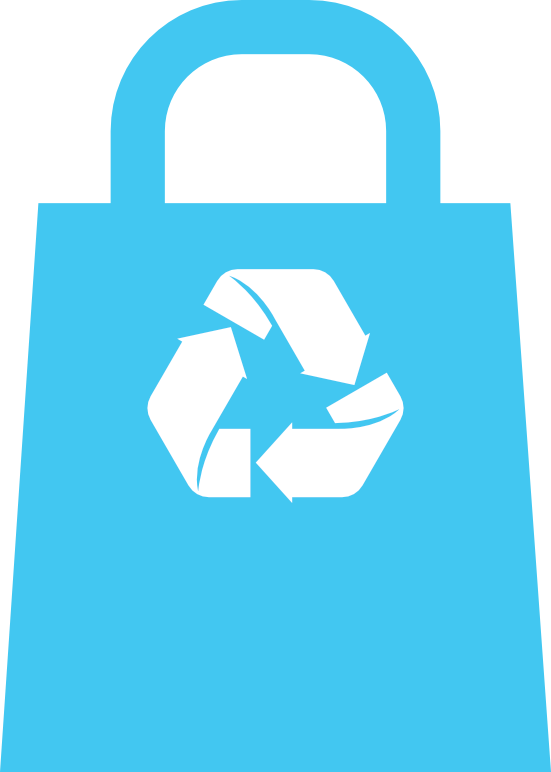
Many of our friends call us tree huggers. Or greenies. And they use this as a term of endearment – most of the time. But they do it because they think we go too far, or push too hard. We like to think that we Go Beyond to achieve more for the environment, our suppliers, our customers, and the people who work for and with us.
We have been asked the question of how making new watersports equipment with virgin raw materials (carbon, plastic, fibre glass, fabrics etc) aligns with our passion for the three r’s (reduce, reuse, recycle). And we struggled ourselves with the prospect of getting kit made in countries with such poor reputations for environmental protection, health and safety and employment rights.
We thought about the many things that we could do and put together a list of things that other companies do:
These are all massively important in their own way, and all achieve very good things. Some companies deserve plaudits for the work they do, and we have a sneaky admiration for some of Starboard’s principles, who seem to walk the walk, not just talk the talk (1). And we use some of these ourselves – for example we support Trees for life by donating to plant trees to support rewilding the Scottish Highlands. But we quickly realised that most of the usual measures employed by other brands failed to tackle the issues that really bugged us. It didn’t do anything about worker’s rights or environmental protection in the far east for example, and it didn’t do anything to really reduce the impact of making lots of brand new kit using lots of raw materials and lots of energy.
We realised we needed a totally new way of doing things, and so we went back to the drawing board to see how we could build a totally different new sustainable business model. A model that didn’t look to drive costs to the lowest common denominator – a sure fire way of tempting companies to cut corners with environmental protection and works rights – and that didn’t require us to keep trying to persuade our customers to get rid of their one year old kit to buy new stuff.
So we’ve looked at the entire SUP supply chain, and our entire product cycle to make sure that we have minimised our impact as much as possible, and embedded ethical principles throughout McConks. So what are these principles?

We realised we needed a totally new way of doing things, and so we went back to the drawing board to see how we could build a totally different new sustainable business model. A model that didn’t look to drive costs to the lowest common denominator – a sure fire way of tempting companies to cut corners with environmental protection and works rights – and that didn’t require us to keep trying to persuade our customers to get rid of their one year old kit to buy new stuff.
So we’ve looked at the entire SUP supply chain, and our entire product cycle to make sure that we have minimised our impact as much as possible, and embedded ethical principles throughout McConks. So what are these principles?
OK, so we’re not really a clothing company (although we have got some awesome sustainable threads), so the lyrics don’t fit perfectly. But you get the gist. Consumerism can be the enemy of the environment, of social justice, of equality. Especially if companies are driving change for change sake – changing fashions, changing colours and pushing consumers to buy a new product every single year. Even if this year’s product is exactly the same as last years, just a slightly different colour or style. Or if products are made to fail at the end of their warranty period. Or if they make cheap products that are not good enough quality, and most people will only use for a short period of time before buying a product that actually works.
As we’re writing this, it’s Autumn. We’re just at the point of the year that all of the magazines fawn over all of the new lineups from the big brands. All launched just in time for Christmas, with plenty of magazine inches and youtube airtime demonstrating just why an extra 5g off this, or an extra 1cm here and there makes all that difference right? And the colours have been refreshed to make them more modern. Or maybe they’ve been made more retro, and that matches your personal brand or style better than last year’s colours.
Now, don’t get us wrong, development, innovation and improvement are really important. And there have been some step changes in SUP/iSUP that have warranted whole new lineups. So the step change in weight and manufacturing technology adopted by the best brands in 2016/17 is one such example. But these huge step improvements are few and far between, and they certainly don’t justify an annual upgrade cycle for every board in every major brands lineup in our opinion. But most ‘game changing’ improvements don’t, sadly, actually improve performance. That’s certainly true for most claimed improvements in dropstitch technology in the period 2016 – to 2020 for example. The lightest and strongest dropstitch and layup technology is still the one we switched to in 2016 (German technology woven drop-stitch). Any brand who is shouting about new and improved technology is either only just catching up, or looking to cut costs by moving to cheaper (2). The fact remains that most performance improvements only serve to lighten your purse/wallet, and create more waste!

We’ve deliberately stepped away from this annual cycle. We only change our products when they need to change. Because we don’t have private equity investors to keep happy in the short term, or bonds to service, we don’t need to convince our customers to buy a new board every year or two just to make short term profit.
We design our boards to last our customers for years, and make them from the very best components and without cutting any costs, to make sure that they do just that. There aren’t many suppliers who meet our high ethical
standards, and we’ve chosen the only supplier that meets the very best standards in terms of product quality, environmental protection, worker welfare and health and safety. There are cheaper ‘top quality’ factories out there, but they don’t meet our environment or worker welfare standards. And there are much cheaper factories out there, used by some very familiar names in the surf and windsurf world, but they don’t meet any of our standards.
We’ve been using our current technology for over three years. And boards that have been used day in, day out, by instructors and rental centres, look as good today as they did on the day they left the factory. And that’s probably why we were voted #1 for longevity in an independent survey of over 1000 paddlers and instructors in 2018.

Because we don’t bring out new lineups every year, because we try to keep our designs broadly the same to remove the risk of vanity/fashion upgrade purchases, it’s really important that our boards and paddles last, and look as good as they did on the day they were bought for year after year. So we have a long term arrangement with our suppliers to make sure that this happens. So that’s not to say that we’ll never upgrade our designs or colours, just that we will only do so if there’s a real need to do so. If you compare our 2016 to our 2017 boards for example, they are quite different. But there was a real step change in manufacturing quality and process at that point in time, and we took advantage to refresh our design.
We know that some will claim that this is just cover for the fact that we don’t invest enough in design and innovation, or that we don’t recognise the importance of second hand products in bringing new paddlers to the sport.
For the first of these criticisms, there is some truth in this. We keep our prices down by not having large design teams who obsess about the difference between slightly different colours or fonts, and by not having expensive branding consultants who obsess about driving a single brand image and palette through the business. We focus our design effort and innovation on the shape of the board or paddle for example, and the materials used rather than the colour. It’s about form and function, not fashion.
We only make products that our customers tell us they want, and where we offer something different. We’re not in the business of creating demand just to sell more product. This is something that we feel very strongly about. We don’t believe in creating demand just to keep meeting short term investment targets to keep investors happy. So what one person interprets as ‘innovation and development of a new product’ another person sees as a product looking for a customer.
So this is one area where we believe we have the biggest impact on the environment. By not artificially creating demand for new products every year, we reduce overall demand, reduce raw materials and reduce waste at the end of the process.

It’s rather unfashionable in the world of sound bites and positive branding to define yourself by what you don’t do. But we’ve never followed the crowd. And we think what we don’t do is just as important as what we do.
What we don’t do is buy cheap tshirts, baseball caps or car stickers in bulk from the cheapest factories in China just to give away and act as low cost advertising. We don’t make products just for the sake of making products and using our customers as free advertising. And when we do launch a new product line, we have considered the materials and the environmental impact of that product from the word go. So for example, our range of t-shirts and hoodies are made from recycled materials of a mix of recycled plastic bottles and fishing nets, and salvaged fairtrade organic cotton waste from the textiles industry, and our rash vests are made of recycled ocean waste. Even our dry bags are made from factory off-cuts of PVC, and our fin boxes and standard fins are made from recycled plastic bottles.
We are also looking to replace some of our raw materials in our other kit with recycled or waste products, but this is still work in progress. We’ve found that it’s very difficult to guarantee product quality and longevity when you’ve not got control of the quality of the raw materials, and that is a necessary evil of using recycled components. But we’re working hard to make this happen in the very near future.
And we are exploring ways in which we can produce some of our products closer to home in the UK and Europe. Hopefully we’ll have some really exciting news to share before the start of 2018 about bringing the production of some of our products to the UK. But there are two possible reasons for us not to push this too hard. Firstly, having products made in developing countries, if done with the right controls and standards, helps to develop countries that really need our investment and support. And secondly, there is a financial cost, and it’s really important to us that we make boards, paddles and gear at a fair price when compared to other brands. And making goods closer to home often comes with a financial cost that we need to consider.
And it’s not just about the stuff that we sell either. Every asset we buy for the business, whether that be a new design computer, a new van or a new lightbulb, sustainability is at the heart of that decision. For example, our IT equipment, we either buy second hand and upgrade, or we buy new, making sure that the asset can be upgraded and repaired with new component in the future. At the end of it’s lifecycle, we reuse all of our IT and comms devices by gifting them to development charities, making sure that it all has a future life.

We work really hard to buy in bulk and ship in bulk to reduce the carbon cost of shipping. We try very hard not to use air to ship products from China. This is a totally unsustainable practice – air freight is one of the worst contributors to carbon emissions and man-made climate change. There are times when we have needed to, but we are trying to schedule our production runs to remove the risk of this happening in the future. And we’ve started talking to other smaller UK companies to share shipping containers, which will both reduce cost and reduce carbon impact.
It’s not just about the shipping costs from our suppliers to us. We also burn a lot of fuel getting our kit to our customers. And there are some courier companies that have very different ethics to us. So we select our courier and delivery companies very carefully. There are lower cost delivery companies we could use, but we’ve all heard the stories of zero hours contracts and ‘self employed’ local delivery drivers having to work 14 hours just to complete their delivery rounds on less than minimum wage. We try our hardest to work with delivery companies that have directly contracted drivers, who employ state of the art real time logistics planning software to make sure they minimise the number of miles they do on the delivery rounds, but that also meet the standards of service expected by our customers.

Energy sustainability is one of the important questions we use when choosing our suppliers. But it doesn’t stop there. We have an impact at McConks HQ, and we mitigate that impact by:

We reuse packaging wherever possible, and have entirely removed petroleum based plastic from our packaging. For goods packed in the UK we now only use paper rather than plastic packing tape, and soon all of our products made in China will also be sealed with paper tape. If you order a fin from us, you might be surprised to see that it comes in an upcycled jiffy bag. And if it does come in a new jiffy bag, it will be an FSC or recycled bag, made of very lightweight materials to reduce fuel consumption in deliveries. And all of our boxes are made from FSC pulp sources, and all of the paper that we use in delivery labels is reused paper or recycled paper.

And this means no glossy brochures. In our quest to really embrace the 3 r’s, we try very hard not to produce printed materials at all. After all, the first step to sustainability is to reduce before you seek to reuse and then recycle. We’ve been criticised for this in the past, and we’ve been told that it will damage our brand because people expect a glossy paper catalogue or brochure. And we’re pretty sure that we’re not as attractive to some bigger companies with big procurement departments who expect to see glossy brochures, and who see these glossy brochures as a sign of quality and brand strength. We try really hard to make our website and shop as engaging and easy to read as possible on any device to prevent the need for paper copy. And in this day and age is there really a demand for paper marketing materials, other than to force your products under peoples noses and remind them that you exist? We don’t think so, so we’re standing firm on this!

In fairness to all of our current and future customers, we want to make it clear that we offer lower prices to instructors, schools, businesses and charities. We do this for a number of reasons:
We also offer preorder prices to businesses, instructors, schools etc. One of our biggest challenges as a small company is cashflow, and having enough money available when we need it to order lots of boards. The more we order in any single shipment reduces our costs: Our suppliers charge less per board as our order volume goes up, and our overhead costs such as our shipping charges and design costs are less per board. So if companies are willing to pay in advance and wait for the boards to be delivered (assuming of course that they are buying at the same time as we are ordering a new shipment) we can share those lower costs with the businesses. McConks benefits by having more businesses using our kit, and the businesses benefit from getting a really good price.

Some small businesses rely on the profit from sales of kit to kit their business running, and our business model doesn’t work for these outfits. We will happily support them with trade prices to use our boards for their lessons, or to hire to customers. But we don’t allow them to buy at our trade prices and then sell at a higher retail price to their customers. There are two important reasons for this:
Firstly, we want anyone who is recommended a board by any professional to know that they are being recommended purely on the basis of quality, price, and appropriateness. Not on the basis of how much margin the company will make.
Secondly, one of the reasons our prices are so competitive is because we have removed the distributor and retailer’s margin from our direct sales retail price. Quite simply, if all of our kit was sold at the trade prices we give to our partners, we wouldn’t be in business next year.
Most companies understand this and we have a great relationship with many clubs, companies and instructors who don’t use our kit for these very reasons. But there are some who don’t agree with our model, believe that direct sales models like this aren’t good for the development of the sport. We obviously don’t agree with their opinion, but we do respect their opinion. And hope that they respect ours!
How do we justify running a SUP company given our principles and beliefs? It isn’t easy, but we’re pretty confident that our business model is unique, starting out with environmental protection, grass roots development, and ethical production as our founding principles. Making deliberate decisions to make products that last and doing away with the annual consumer upgrade cycle is really important, as is using a fair and ethical pricing framework. We can only get away with doing this because we have no shareholders or funders trying to generate profit as quickly as possible on the back of you, our lovely customers, on the back of damage to the environment, or on the back of workers in developing countries. We know that no other company makes packages and paddles of the same quality as us, at the same price point, and with the same ethics. And we’re rightly proud of this.
So we might not have pockets as deep as the big watersports brands, and we might not have lots of fancy glossy brochures and cheap, disposable merchandise. We won’t have ‘fresh new colours’ every year, and we certainly won’t be giving away cheap American style baseball caps and waterproof key bags that end up landfill.
But we do have a clear conscience, and we can sleep well every night!
If you ever catch us not staying true to these ideals, promises and ethics – tell us. And if we don’t listen, tell others. We believe in these ideals and need to be held to them!
(1) https://www.continentseven.com/interview-svein-rasmussen-starboard-joins-sustainable-surf-ecoboard-project/
(2) We can guarantee that all boards you buy under £500 are made from a Chinese generic copy of dropstitch, which is lower density and fails much more regularly than the original. Even the one factory that makes the very highest quality German tech drop stitch in the world, also makes really low quality drop stitch for gym mats! FAST FACT – did you know that the price of drop stitch fabric varies from $2 per square metre to over $100 per square metre. You really do get what you pay for with iSUP as long as you choose a company you can trust, and not one that artificially inflates prices to make their sale prices look attractive. We’d like to say that no UK companies do this, but sadly, many do.